Impressions vs Views: What’s the Difference Between Them?
Understand how impressions vs views are measured across different social networks, what they represent, and how to optimize for each.

You’ve probably seen both impressions and views in your analytics reports—but do you know what they actually mean? These two metrics might seem similar at first glance, but they represent very different stages of user engagement. And with each social platform counting them differently, it's easy to misread your performance.
Let’s clear up the confusion and explore what impressions vs. views really tell you about your content.
Key takeaways
-
What's the core distinction between impressions and views: Impressions reflect potential exposure, while views indicate that someone actually paid attention to your content.
-
Metric's importance depends on the goals set: Use impressions when your goal is broad visibility—like launching a brand or entering a new market—and views when you're measuring impact, interest, or conversions.
-
The best approach for effective reporting is to combine native analytics data with third-party tools: To get the full picture, combine native platform data for immediate insights with third-party tools like Socialinsider for historical trends, benchmarking, and deeper analysis.
What’s the difference between impressions and views?
Why is it important to understand the difference between impressions and views in today’s social landscape?
When I first spotted Instagram switching from impressions to views as the primary metric, I did a double-take. It completely reshaped how we evaluate visibility. Earlier, views were reserved for Reels, but now they’re used across Stories, carousels, and static posts. And while that might sound like a small change, it shifts the entire lens through which we understand content performance.
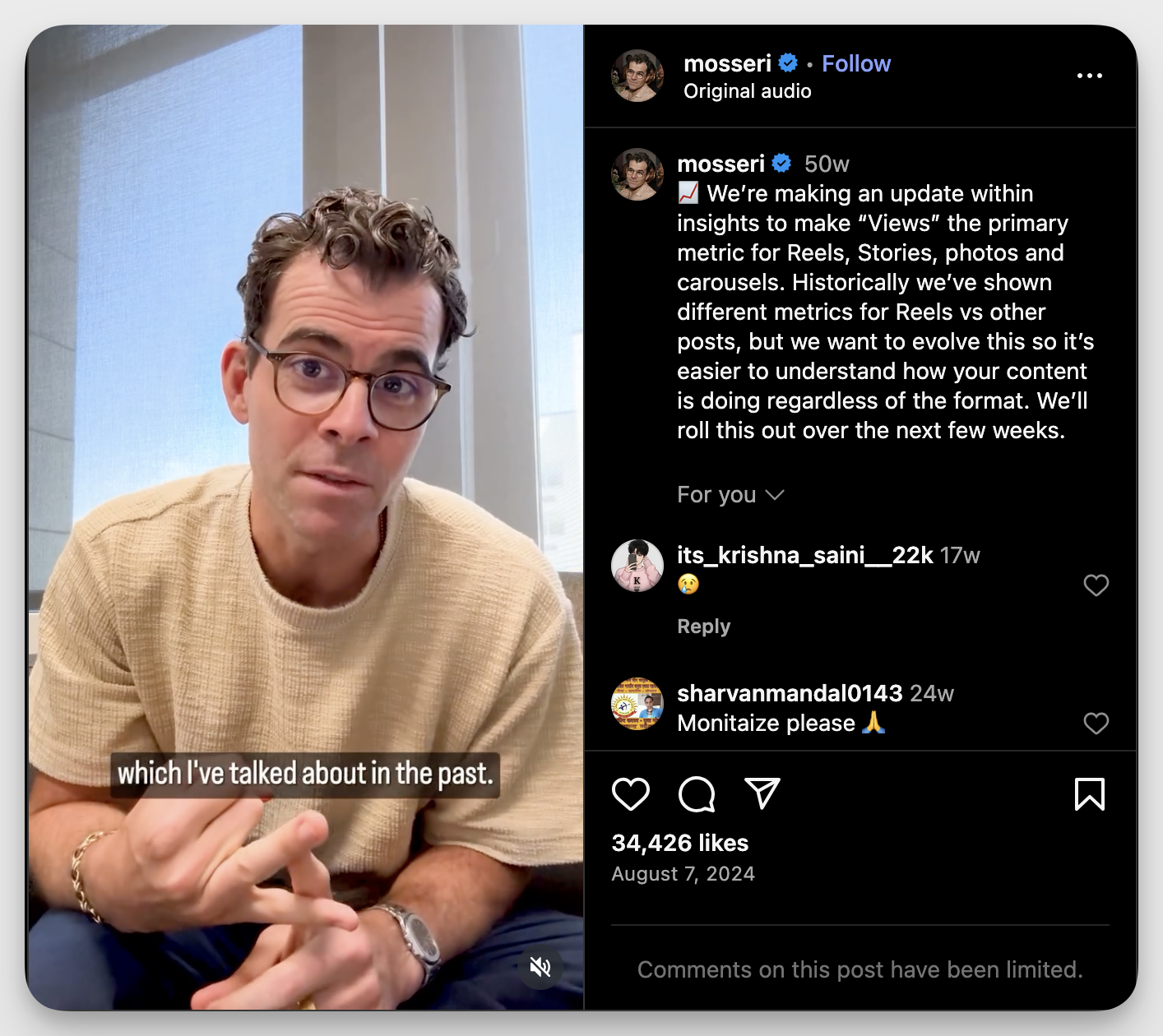
A “view” now implies attention (or at least the suggestion of it) while impressions were more about content simply loading on a screen, whether or not anyone actually saw it.
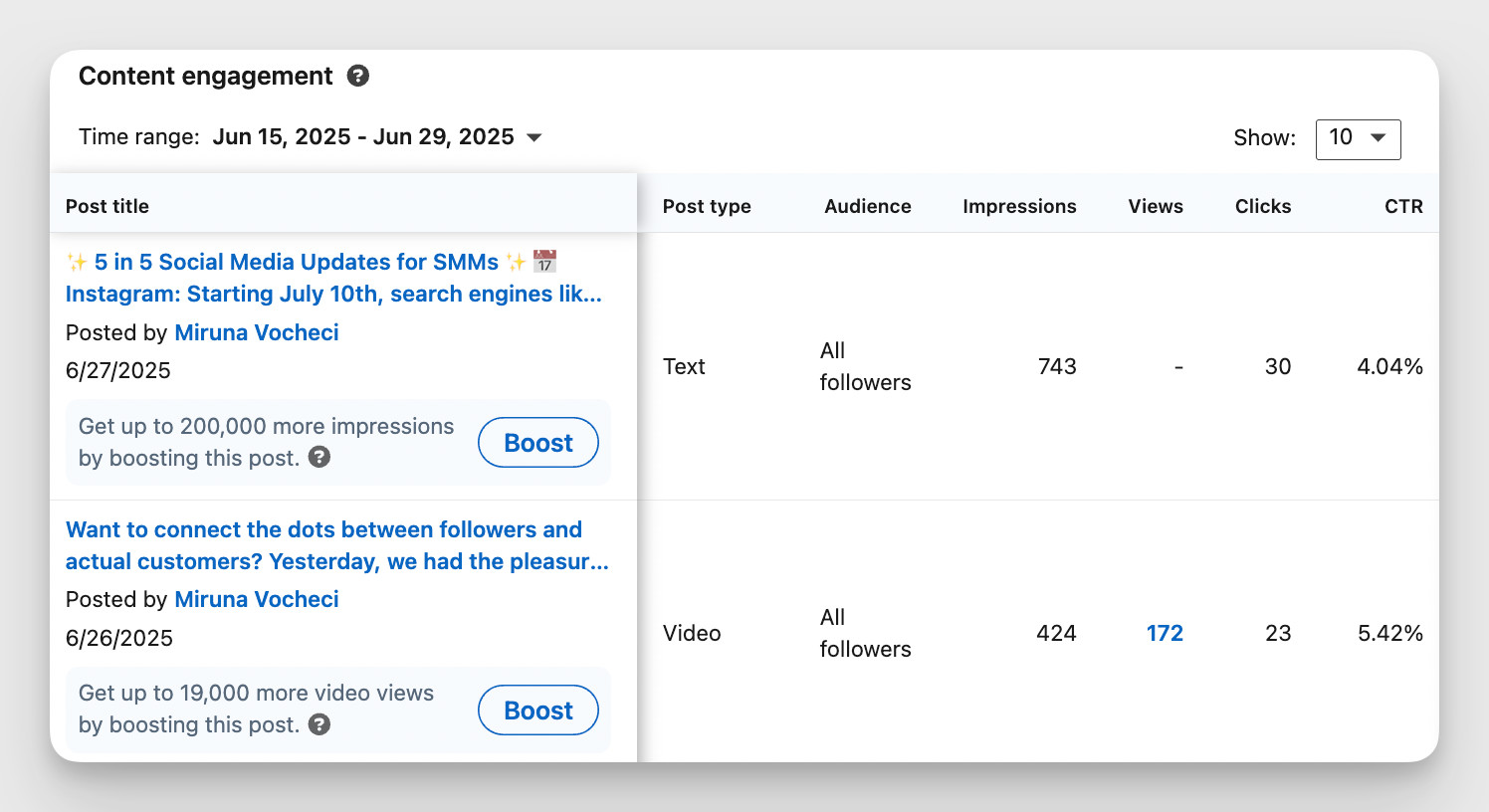
Meanwhile, LinkedIn continues to hold onto impressions as the go-to metric for most content formats, and for videos, it tracks social views separately.
This platform-by-platform inconsistency creates a lot of noise. Personally, I find this split a bit of a metrics minefield. If you’re comparing performance across platforms without understanding how they count these things, you’re setting yourself up for bad decisions.
So whether you’re building reports, pitching to clients, or optimizing your next campaign, knowing the difference between impressions and views isn’t optional anymore. It’s the only way to know if your content is actually being seen… or just passing through unnoticed.
How does each social network display impressions or views
Whether Facebook is on your priority list or it’s a mix of Instagram, TikTok, and X, let’s understand how these social platforms count impressions and views.
Facebook tracks impressions across all content formats — photos, links, text, videos. An impression is counted each time your content loads on someone’s screen, even if they scroll past. For views, the metric applies only to Reels. A view counts when a Reel plays, signaling actual user attention.
Recently, Meta has been nudging creators toward using views as the main performance signal, especially for short-form video. That said, impressions are still critical as a Facebook metric for measuring reach, especially for non-video content.
What to track and why it matters
Let’s take an example to understand this:
You post a photo that racks up 5,000 impressions but zero views (because Facebook doesn’t track views for image posts). That tells you your content was frequently displayed, but there’s no way to know if people actually stopped to look.
Now compare that to a Reel with 1,200 views. That number isn’t just about visibility; it indicates people actually paused to watch.
Both metrics are valuable, but they serve different purposes: impressions reflect potential reach, while views capture actual attention.
How to use Socialinsider to track Facebook metrics
- Go to Posts inside your Facebook page.
- Sort by Views to see how your content performed. You can even sort through impressions here.

- Though you can sort through impressions using the earlier step,we have an additional, dedicated section for Impressions. Switch to the Impressions section through the left sidebar for deeper data.
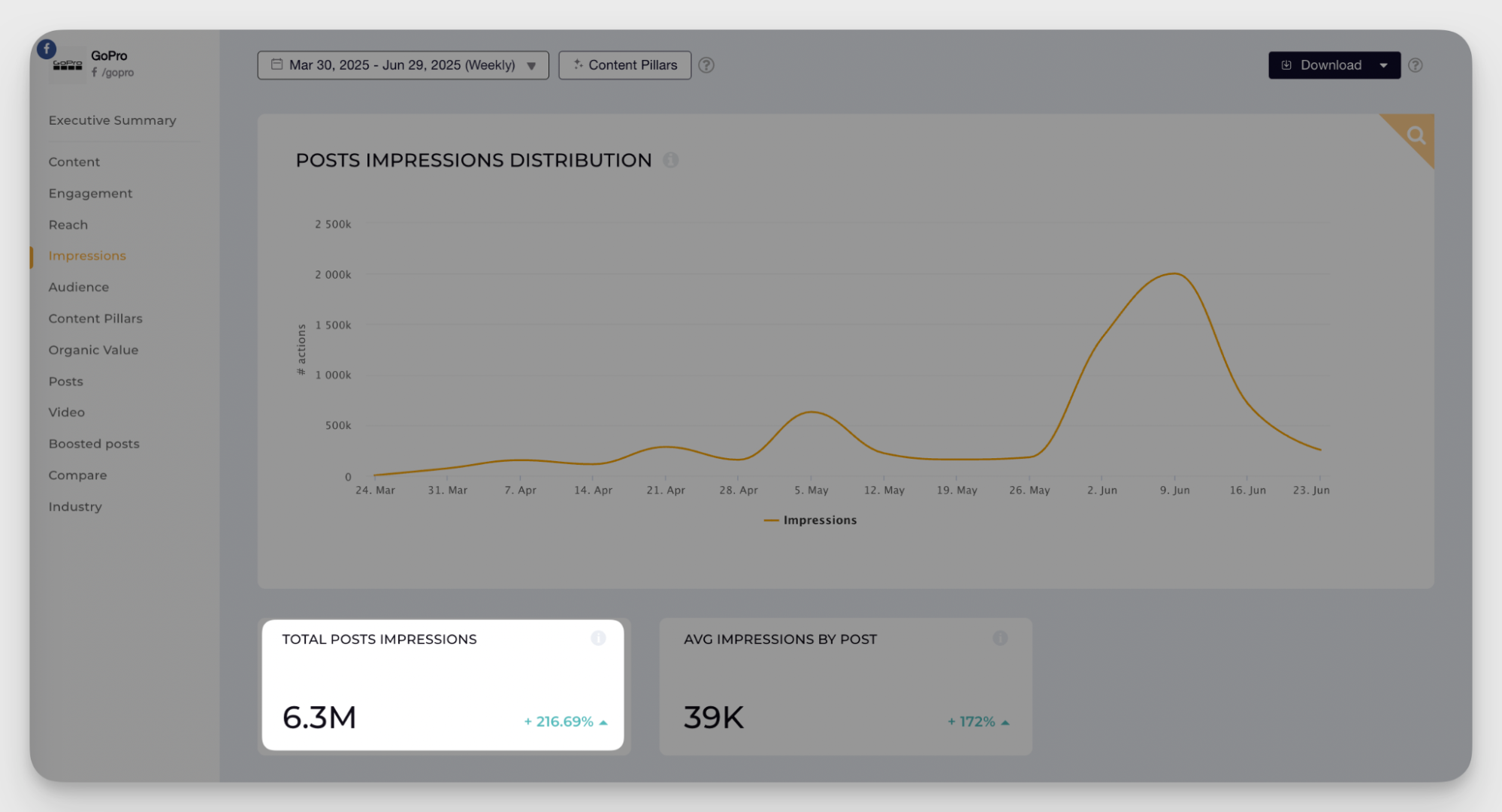
Instagram has shifted entirely to views as its core metric across all content formats, whether it’s a photo, carousel, or Reel. This move replaces impressions and standardizes how content visibility is measured.
What is counted as a view on Instagram?
According to Meta, a view is counted the moment content appears on screen. For Reels specifically, it must auto-play for at least 3 seconds to be logged as a view.
Note that multiple views from the same user are possible. However, Meta has precautions in place to stop users from falsely increasing view counts. For example, if someone watches a video repeatedly in quick succession, only the first view is counted. To count again, there needs to be a time gap between plays.
How to use Socialinsider to track Instagram metrics
- Open your Instagram page in Socialinsider.
- Go to the Posts section
- Sort posts by Views.
- Or to get deeper overall data, you can directly head to the Views section on the left sidebar.
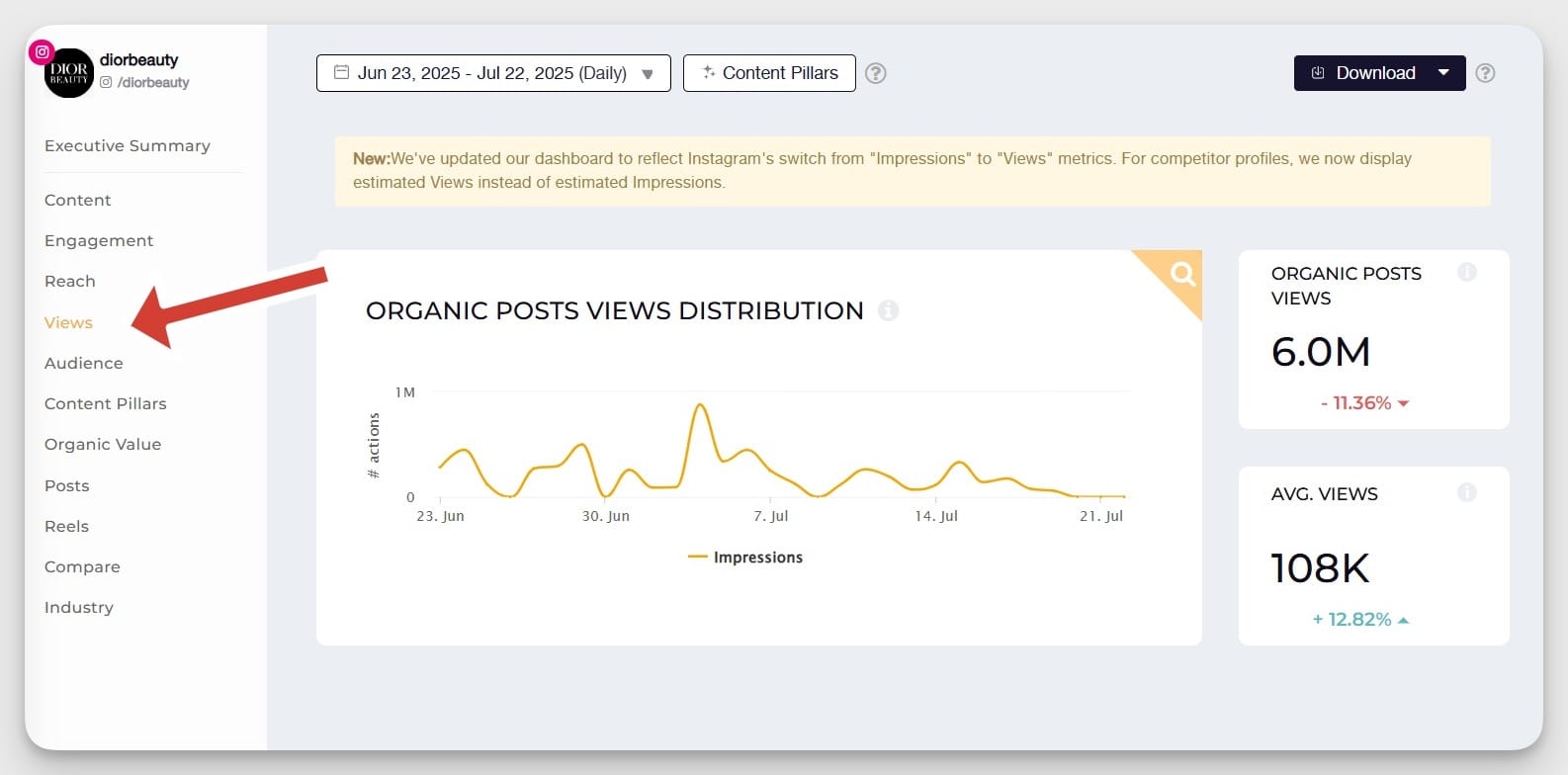
Unlike Instagram, LinkedIn has impressions for all content formats and views for videos. Whether you’re posting thought leadership, carousels, or videos, each metric tells a different story.
How are Linkedin views vs impressions measured
An impression on LinkedIn is counted every time your content appears in someone’s feed, regardless of whether they engage with it. That means a single user seeing your post multiple times counts as multiple impressions.
Video views, however, are more selective. LinkedIn logs a view only when someone watches at least 2 seconds of your video while at least half of it is visible on their screen. This makes views a stronger signal of actual attention, while impressions are useful for tracking reach.
How to measure LinkedIn metrics with Socialinsider
- Go to your LinkedIn page and open the Posts section.
- Sort by Views to analyze video content performance.
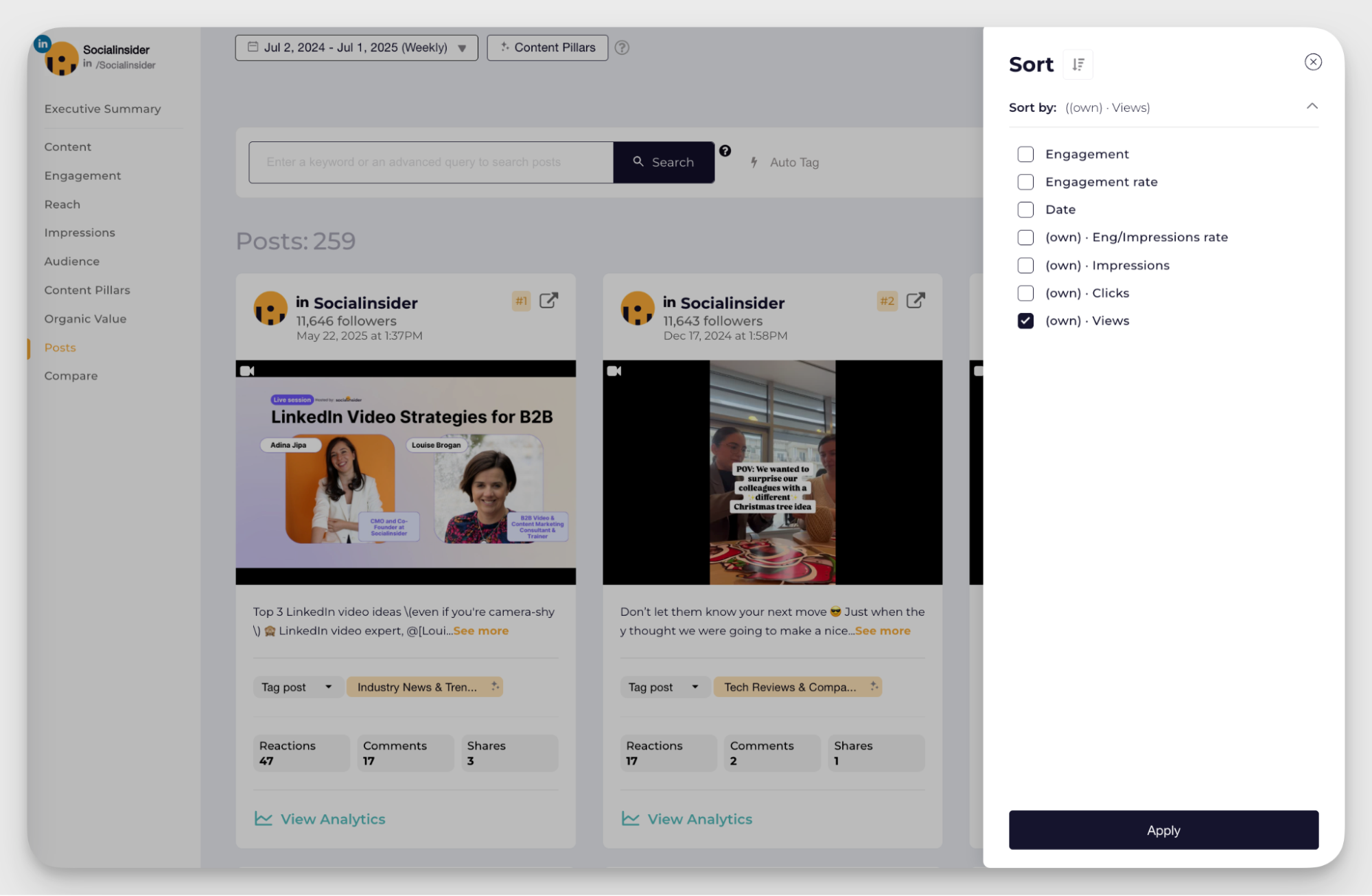
For Impressions, you can go to the dedicated tab for deeper insights like your top-performing formats and impression trends over time. This offers more in-depth data, such as the best content type for impressions for your brand and an evolution to identify trends.
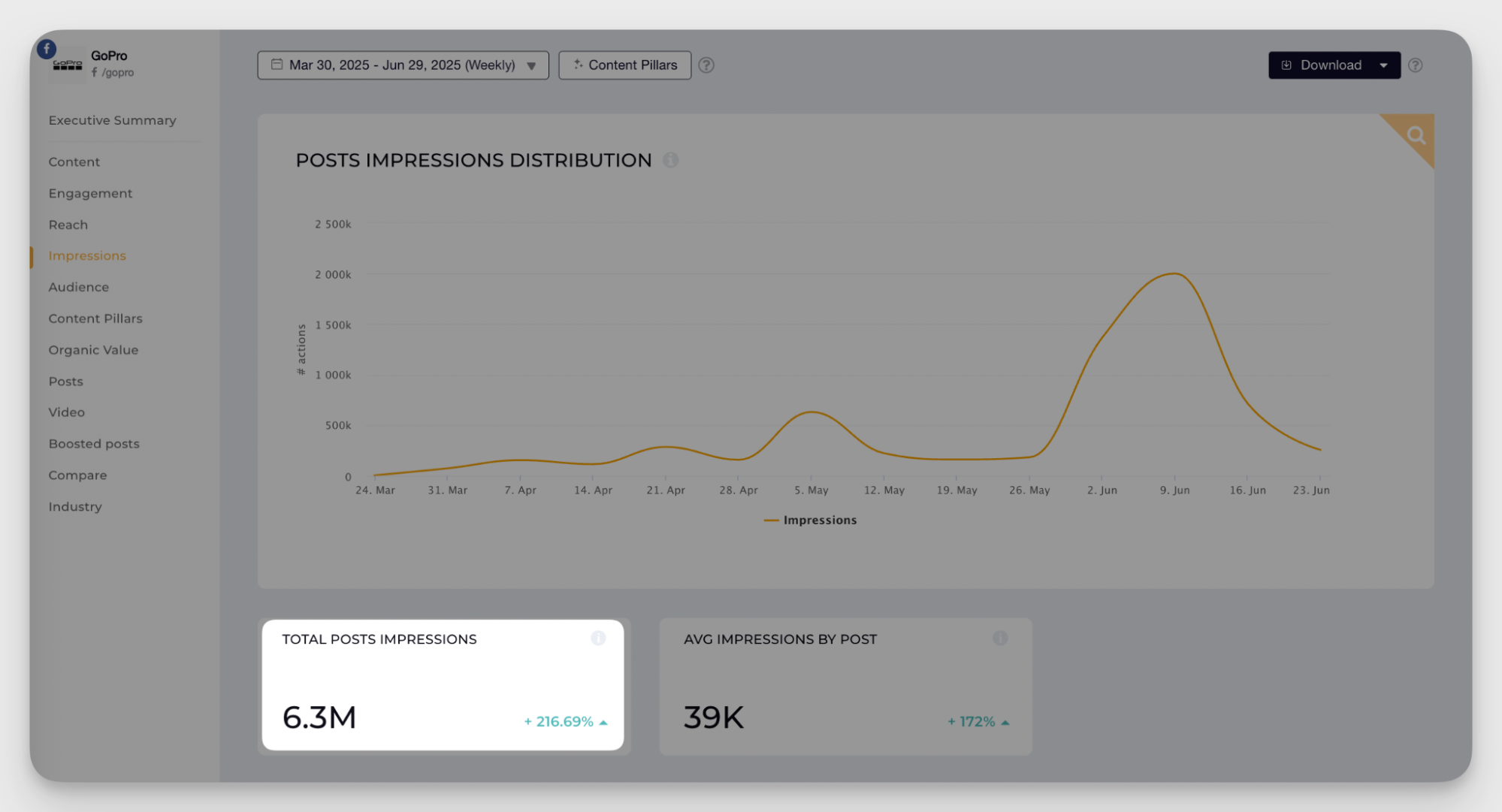
YouTube
On YouTube, not all exposure is created equal, which is why knowing the difference between impressions and views is key to evaluating how your videos are actually performing. These two social media KPIs serve very different purposes in YouTube’s algorithm-driven ecosystem.
What do views and impressions mean on YouTube?
An impression on YouTube is counted each time your video’s thumbnail is shown to a user on the homepage, in search results, or in the ’Up Next’ panel. It doesn’t mean someone clicked, just that they saw the opportunity.
A view, by contrast, is recorded when someone actively clicks and watches your video for at least 30 seconds, or finishes it if it’s shorter. This makes views a much stronger measure of real engagement.
How to measure YouTube metrics with Socialinsider
- Open your YouTube page in Socialinsider.
- Go to the Videos tab. Sort videos by impressions to check how often your thumbnails are displayed across YouTube.
- Switch to Views to analyze which videos users are actually watching. Review view trends over time to understand what types of content gain the most traction.
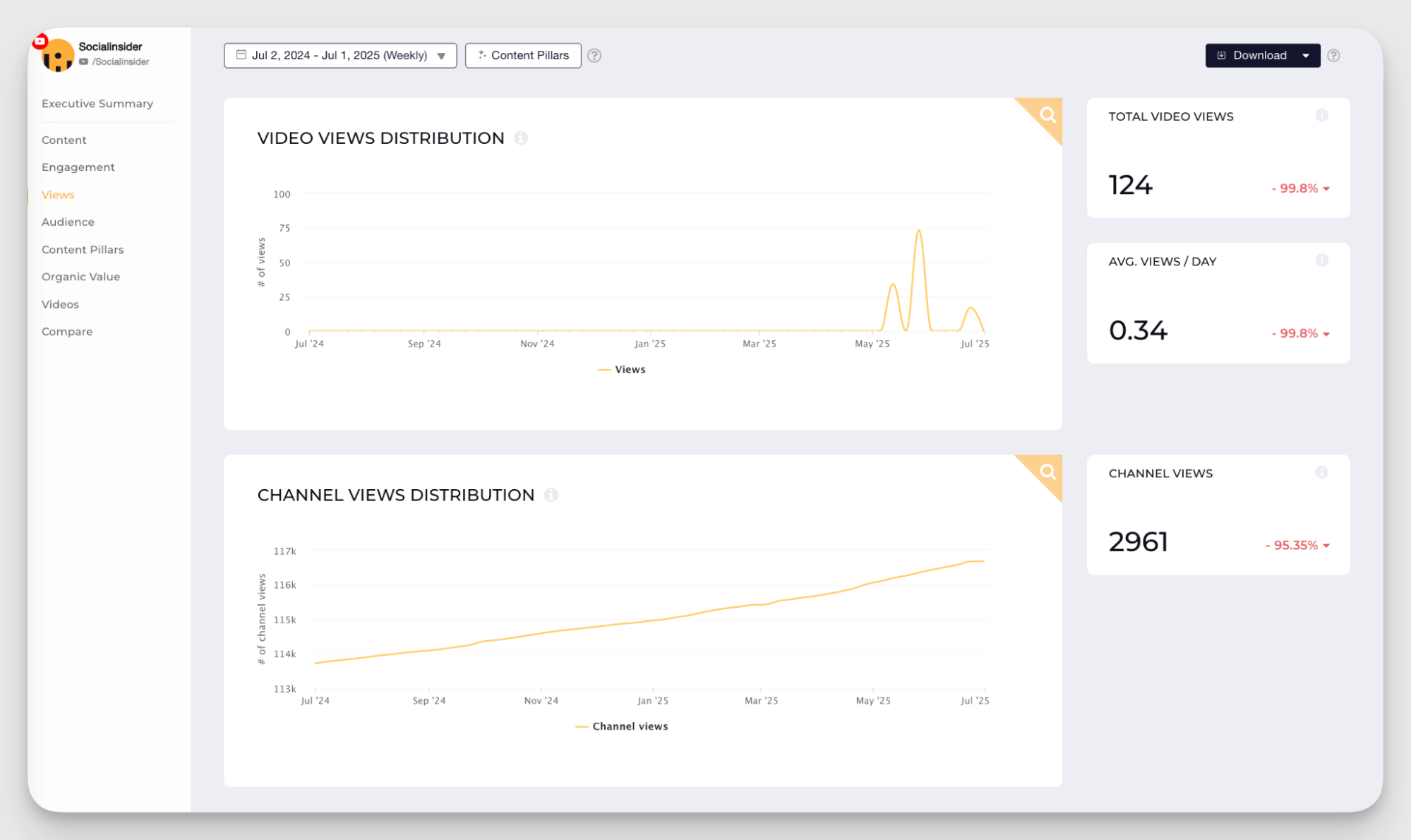
TikTok
On TikTok, the only metric that truly matters (and the only one that’s even available natively) is the view count. There are no impressions, no partial metrics, just views. This simplifies things, but also raises the bar. If your content isn’t being watched, it’s not being surfaced.
With TikTok’s algorithm built entirely around visibility and watch time, understanding how views work (and how to track them) is non-negotiable for creators and brands alike.
What counts as a view on TikTok?
A view on TikTok is recorded the moment your video starts playing. There’s no time threshold like on YouTube or LinkedIn. Even autoplay counts. That means views can add up quickly, but it also means they’re less about deep engagement and more about visibility.
TikTok’s algorithm uses early view velocity (how quickly a video gets views after posting) as a key signal for further distribution. So tracking view spikes over time can help you understand how your content is picked up and pushed.
How to measure TikTok metrics with Socialinsider
- Connect your TikTok profile to Socialinsider.
- Navigate to the Views section to analyze the total views distribution.
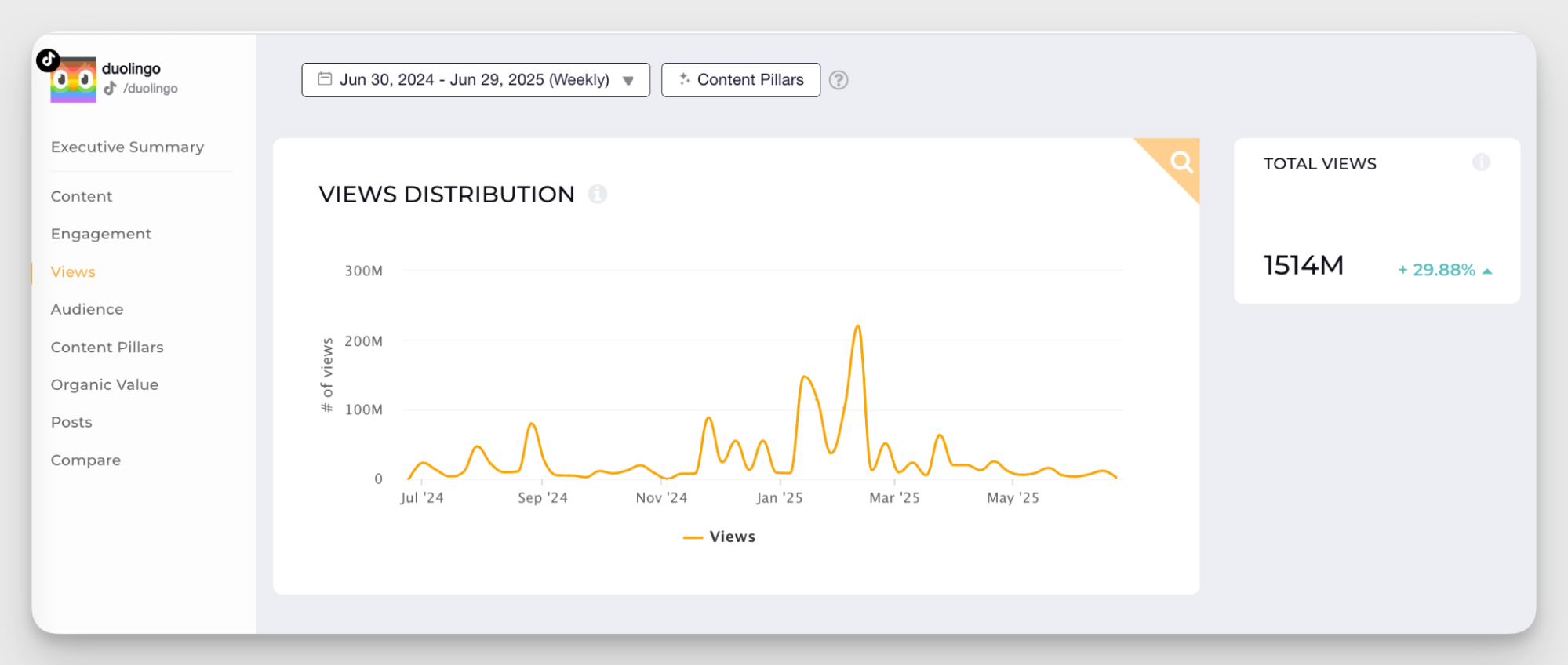
- You can even head over to the Posts section, and filter posts by peak view rate, no. of days until peak views, no. of views in day 3, and other important metrics.
X (Twitter)
On X, both impressions and views are available, but they serve different purposes, and understanding the difference helps you make sense of what’s working. As the platform continues to evolve, Twitter views vs. impressions and when to prioritize one over the other become vital in how reach and visibility are evaluated.
What counts as a view vs. impression on X?
An impression is counted every time your post is shown on a user’s timeline or in search results. It includes repeated post views from the same person, so it’s a strong signal for measuring content reach.
Views, on the other hand, are mostly limited to video content metrics. A video view on X typically requires at least 2 seconds of playback with 50% visibility on screen, similar to LinkedIn. While X shows public view counts for tweets, impressions remain the more reliable metric for tracking distribution.
How to measure X metrics with Socialinsider
- Connect your X profile to Socialinsider.
- Go to the Posts section through the left sidebar.
- Sort by Views to analyze which posts are generating the most views.
- To check impressions, go to the dedicated Impressions tab for in-depth visibility metrics. Use this insight to improve post timing, hooks, and format strategy.
When to prioritize impressions vs. views on social media: a sneak peek
When to prioritize impressions?
We’ve already explored when post impressions matter most. Now let’s dive deeper into those scenarios and the key metrics you should track alongside them.
Primary scenarios
We already know why impressions are important when your focus is on reach over clicks. Here’s when to prioritize them:
- New brand or product launch: Visibility is everything at this stage. Before engagement or conversions, you need awareness. A new skincare brand, for example, should aim for high impressions to get its name and product benefits in front of as many users as possible.
- Category education: Repetition is key if you’re introducing a new concept, say an AI-powered contract analysis. Impressions help reinforce unfamiliar messaging until your audience begins to understand and trust it.
- Standing out from competitors: In saturated markets, impressions help you stay top-of-mind. A newer project management tool competing with giants like Asana needs to repeatedly show up in feeds to build recognition and credibility.
- Geographic expansion: When entering new markets, you’re starting from zero. Impressions help you validate whether your content is being seen in the right regions. A U.S. DTC apparel brand expanding to the UK, for instance, can track the number of impressions on geo-targeted posts to measure initial reach.
Why impressions win?
Let’s go deeper into understanding why brands prioritize social impressions in the above-mentioned scenarios.
- Frequency builds familiarity. Studies show it takes at least 7 brand exposures for people to remember a message or brand before buying into it. If you’re launching a new meal-replacement brand or entering a crowded SaaS category, repeating your message through impressions increases the chances of sticking in someone’s mind, even if they don’t click initially.
- Passive learning matters. Even without engagement, users subconsciously process your brand’s visuals, tone, and offering. A person may scroll past your product three times before they’re ready to click the fourth time. Impressions track that invisible, critical build-up.
- More impressions = more mindshare. When your brand is constantly visible, especially compared to competitors, it claims more mental real estate. That visibility plays a direct role in brand consideration during decision-making.
- It’s cost-effective. For campaigns aimed at reach, CPM (cost per thousand impressions) is typically much lower than CPV (cost per view). If you want to show up frequently without breaking your budget, impressions are the better play.
Success metrics to track
When optimizing for impressions on social media, you need to track related metrics as well. Here are five of them.
- Total reach: Measures how many unique users have seen your content. It helps ensure your impressions aren’t just repeating for the same audience and supports broader brand exposure.
- CPM (Cost per Thousand Impressions): A key efficiency metric. Lower CPMs indicate you’re getting more eyeballs for your budget, which is ideal for awareness-focused campaigns.
- Brand awareness lift studies (aided/unaided recall): These studies measure how well users remember your brand after being exposed to ads.
- Aided recall checks if users recognize your brand when prompted.
- Unaided recall reveals whether users remember you without any hint. This is arguably more valuable.
- Search volume increases for brand terms: A rise in branded search queries after high-impression campaigns is a clear indicator of growing interest and brand consideration.
- Direct traffic growth to website: If more users are typing your URL or brand name into their browser (instead of discovering you through ads or search), it signals that your brand is becoming more memorable and top-of-mind.
When to prioritize views?
While impressions help you get seen, views tell you who’s actually paying attention. In certain scenarios, this deeper level of engagement becomes the real metric to watch.
Primary scenarios
- Community building: If your goal is to build a loyal, active following, especially on platforms like YouTube, LinkedIn, or TikTok, views are a better signal. They show who’s actually watching your content, not just scrolling past it. For example, a fitness coach posting weekly video tips can track views to gauge which topics are resonating with their core audience.
- Thought leadership: Sharing hot takes, industry breakdowns, or original insights? Views help you measure how many people are giving your content enough time to form an opinion about your expertise. A B2B founder sharing market predictions on LinkedIn should focus on view duration and consistency over time to build credibility.
- Educational content: Complex topics, like financial planning, climate science, or SaaS onboarding, require attention, not just exposure. Views indicate if people are sticking around to absorb the value. Without sustained views, you’re not teaching, you’re just broadcasting.
Why do views matter more?
- Algorithm favorability: Social platforms like TikTok, Instagram, and LinkedIn reward content that captures attention. Posts with high view rates are more likely to be pushed into Explore pages, For You feeds, or algorithmic recommendations. In fact, we have also seen Meta now focusing on views only instead of impressions.
- Quality audience signals: Impressions show potential interest; views confirm it. If someone sticks around to watch your 45-second product demo or explainer video, that’s a real signal of intent. Especially for thought leadership or educational content, views indicate that your message is landing with the right people.
- Compound growth: Viewers are more likely to engage, whether that’s sharing, commenting, or following. Over time, these small actions build into a loyal audience base. A DTC skincare brand might get thousands of impressions, but it’s the users who watch their morning routine video all the way through who will eventually convert, refer, or advocate.
Success metrics to track
When optimizing for views on social media, the following metrics give you a well-rounded picture of how effectively your strategy is working.
- Click-Through Rate (CTR): A high view count is only part of the story. CTR tells you how many of those viewers were motivated enough to take action, like clicking a link or opening a product page. If your video gets 10,000 views but only 50 clicks, your call to action likely needs work.
- Conversion rate from views to leads: Especially important for gated content, signups, or lead magnets. Track how many viewers end up becoming actual social media leads or newsletter subscribers. For example, if 5% of your video viewers sign up for a webinar, that’s a strong signal that your content is doing its job.
- Traffic: Measure how much referral traffic your videos are driving to your site or landing pages. Views that don’t translate into visits may signal a disconnect between content and intent.
- Engagement rate: Includes likes, comments, and shares. High views with low engagement? Your content might be watchable, but not compelling.
- Video watch time: This shows how long viewers are sticking around. Longer watch times signal deeper interest and better algorithm performance. Here’s how you can track these video marketing metrics using Socialinsider.
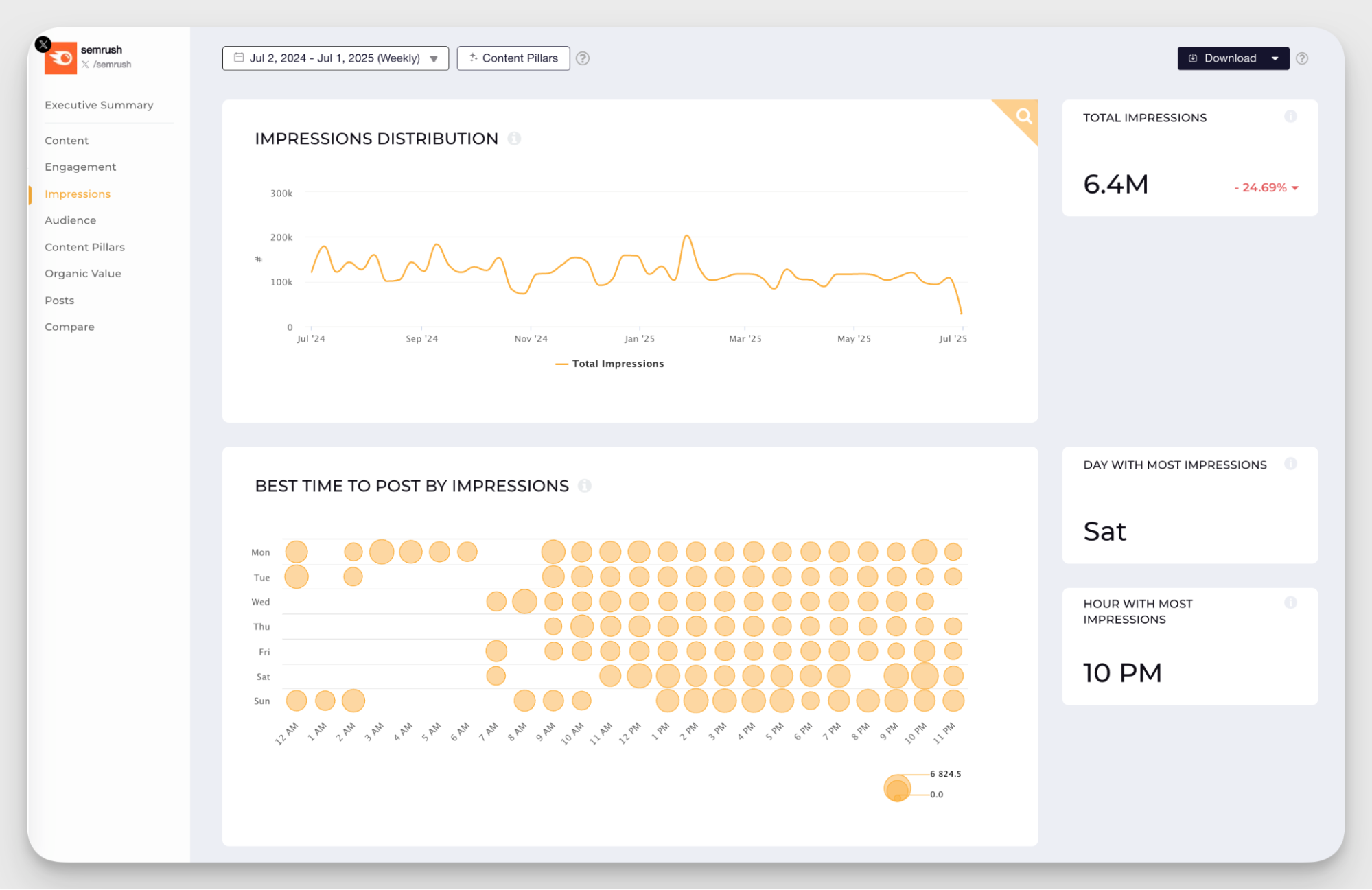
Content formats that prioritize views
If you’re focusing on specific content formats, the ones below are best measured by views.
- Educational tutorials: Step-by-step videos (like ‘how-to’ guides or walkthroughs) hold attention because they deliver clear, structured value. Use captions or overlays to highlight key takeaways and keep viewers engaged till the end.
- Behind-the-scenes content: People crave authenticity. A quick BTS look at product development, campaign shoots, or team culture adds transparency, boosting watch time and connection. Use casual, unscripted formats to make it relatable.
- Story-driven content: Build narrative arcs with a beginning, middle, and end to hook and hold attention. Think customer stories, founder journeys, or mini vlogs. A payoff at the end increases full-view rates.
- Live content: Livestreams boost view duration through real-time interaction. Whether it’s Q&As, launches, or product demos, the sense of immediacy keeps viewers tuned in longer. Promote ahead to maximize turnout.
- Interactive elements: Add polls, questions, or challenges to turn passive viewers into active participants. TikTok duets, Instagram question stickers, or YouTube comments prompts encourage viewers to stay, engage, and return.
How to measure your brand’s views and impressions on social media
There are two ways to check your brand’s views and impressions. Let’s explore each and decide which one to use.
Native analytics platforms
Native analytics platforms like Meta Insights, YouTube Studio, TikTok Analytics, or LinkedIn Analytics are the first stop for tracking your brand’s views and impressions. These tools give you direct access to how often your content is being surfaced (impressions) and actually watched (views). They offer real-time performance data and are helpful for spotting quick wins, like a Reel gaining traction or a video with high drop-off rates.
However, native tools come with limitations. Most platforms only store data for a short time, typically 28 to 60 days. That makes it hard to track long-term trends or benchmark performance month-over-month. You also can’t easily compare metrics across platforms or get deeper insights like content-type performance or audience segmentation.
For teams managing multi-platform strategies or running social media campaigns over time, relying only on native analytics can create gaps in visibility. That’s where we come to the second alternative for measuring views and impressions.
Third-party measurement tools
While native analytics platforms give you the basics, third-party measurement tools like Socialinsider go several steps further. You can get a more comprehensive view of how your content performs across channels, making it easier to track views and impressions side by side on platforms like Instagram, LinkedIn, Facebook, and TikTok.
One key advantage is historical data access. Unlike native platforms that limit data to a certain number of days, third-party tools store performance data over months or even years. This lets you spot long-term trends, seasonal patterns, or the true impact of past campaigns.
They also provide cross-channel comparisons, helping you understand where your content gets the most visibility and engagement. For example, if a LinkedIn video outperforms an Instagram Reel in views, you’ll know exactly why and if you need to shift strategy.

Plus, third-party tools often include advanced filters, benchmarks, and customizable reports, which are ideal for agencies, large teams, or brands running campaigns at scale.
Final thoughts
As platforms shift their priorities and algorithms evolve, the ability to interpret performance metrics becomes a real competitive advantage. Understanding when to focus on impressions vs. views gives you the flexibility to adapt, optimize, and communicate impact more effectively. The brands that get this right won’t just be seen—they’ll be remembered.
Analyze your competitors in seconds
Track & analyze your competitors and get top social media metrics and more!
You might also like
Improve your social media strategy with Socialinsider!
Use in-depth data to measure your social accounts’ performance, analyze competitors, and gain insights to improve your strategy.





